Wireless Medical Technologies Market Size
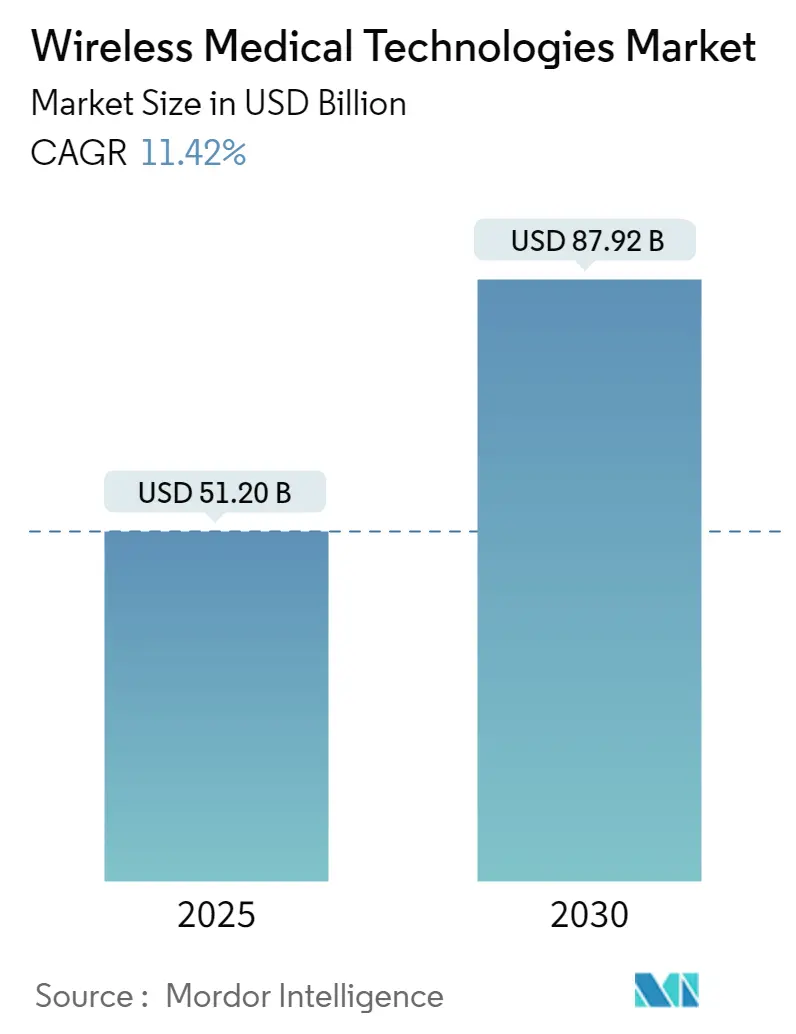
| Study Period | 2019 - 2030 |
| Market Size (2025) | USD 51.20 Billion |
| Market Size (2030) | USD 87.92 Billion |
| CAGR (2025 - 2030) | 11.42 % |
| Fastest Growing Market | Asia-Pacific |
| Largest Market | North America |
| Market Concentration | Medium |
Major Players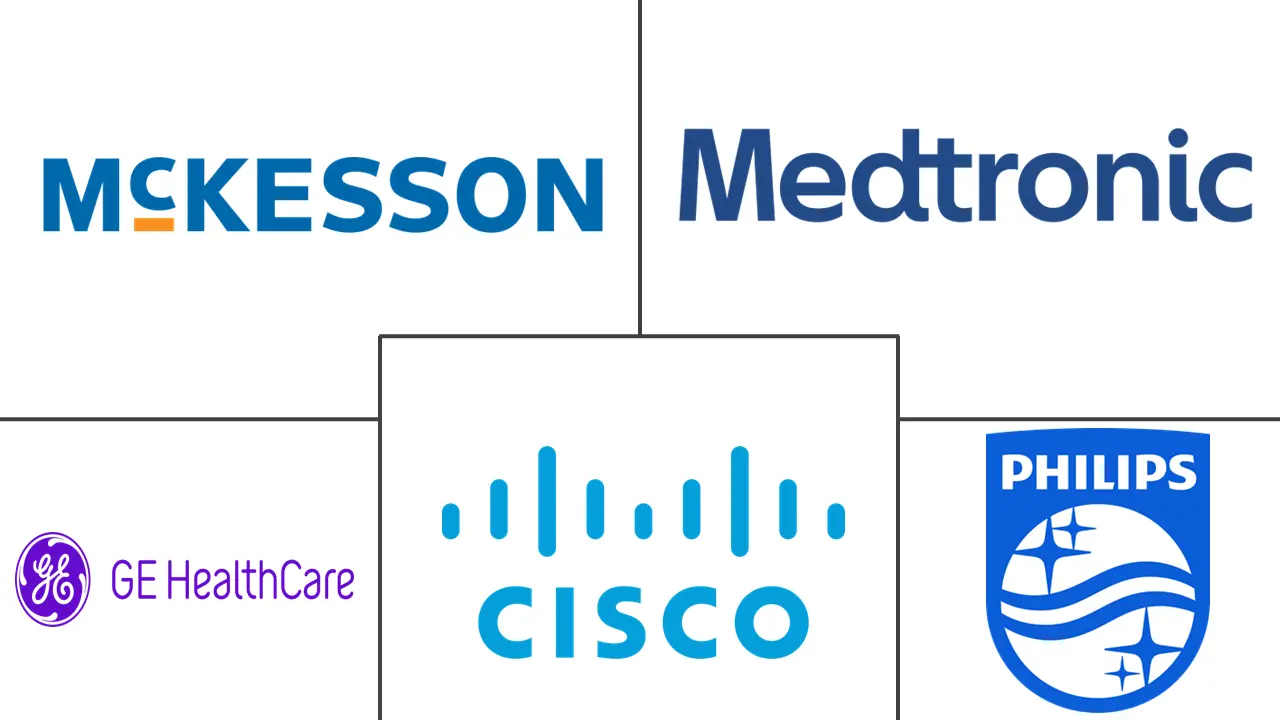
*Disclaimer: Major Players sorted in no particular order |
Wireless Medical Technologies Market Analysis
The Wireless Medical Technologies Market size is estimated at USD 51.20 billion in 2025, and is expected to reach USD 87.92 billion by 2030, at a CAGR of 11.42% during the forecast period (2025-2030).
The major factors driving the growth of the market studied are increasing demand for digitalization of healthcare and rising technological advancements in wireless medical technologies.
Digitalization of healthcare is expected to increase the adoption of wireless medical technologies, which may drive the growth of the market studied over the forecast period. For instance, in February 2022, the Department of Health and Human Services, via the Health Resources and Services Administration, awarded USD 55 million to 29 HRSA-funded health centers to increase healthcare access and quality for underserved inhabitants through virtual care such as telehealth, digital patient tools, remote patient monitoring, and health information technology platforms. According to the Canadian Digital Health Survey of April 2024, the online survey conducted in November 2022 with 12,445 Canadians across all provinces and territories showed that 94% of Canadians were interested in accessing digital health services. Hence, with the digitalization of healthcare, the adoption of wireless medical technologies is expected to increase for better patient medical data transfer and patient monitoring.
In December 2023, AT&T reported joining smart healthcare, which was marked by its commitment to expanding high-speed internet and collaborating with the healthcare industry. Incorporating 5G into healthcare infrastructures markedly improves the speed and reliability with which these large imaging files are transmitted.
Furthermore, in October 2022, Xenter reported the launch of XenFI, the first product in the company's wireless "Technology in Medicine" ecosystem, to improve the adoption of new technology in the healthcare industry. The newly launched product comprises XMD (a HIPAA-compliant, global healthcare cloud) and XenFI-Hub, Xenter's wireless communications device designed for various healthcare settings. Moreover, in March 2023, Amala Hospital launched an innovative smart ward with wearable wireless technology. The smart ward is equipped with advanced technology that offers continuous patient monitoring. The ward aims at improving patient outcomes and reducing the risk of medical errors.
Thus, the increasing digitalization of healthcare and rising technological advancements are expected to drive the growth of the market studied over the forecast period. However, cyber security and privacy issues are expected to hinder the growth of the wireless medical technologies market during the forecast period.
Wireless Medical Technologies Market Trends
The Wireless Body Area Network (WBAN) Segment is Expected to Hold Significant Market Share Over the Forecast Period
A body area network (BAN), also referred to as a body sensor network (BSN) or a wireless body area network (WBAN), is a wireless network of wearable computing devices. A wireless body area network system can utilize WPANs (wireless personal area networks) as gateways to reach longer ranges. Through these gateway devices, it is feasible to connect the wearable devices on the human body to the internet. This way, medical experts can access patients' data online using the internet, independent of their location.
The increasing adoption of WBAN in healthcare and the rising number of chronic diseases are expected to drive the revenue of the segment over the forecast period. According to an article published in Sensors in December 2023, electronic healthcare (E-healthcare) revolutionized the healthcare system, WBANs being an integral part of it. The patient’s personal data can be accessed remotely in real-time from any location by using e-healthcare technology. Furthermore, according to an article published in Scientific Reports in February 2024, in the healthcare industry, while using WBAN technologies, a collection of physical and biological sensors is distributed on the patient's body to monitor health status, biological and physical activities, physiological measurements, or any other objectives.
WBAN helps in monitoring vital parameters like heart rate, ECG, and blood pressure. According to the report published by the British Heart Foundation (BHF) in April 2024, more than 7.6 million people were living with heart and circulatory diseases in the United Kingdom in 2022, which is further projected to increase with the aging population, decreasing fertility rates, and increasing survivability from other chronic diseases. Furthermore, as per the 2022 update from the International Diabetic Federation (IDF), about 537 million adults (20-79 years) were diagnosed with diabetes. The total number of people living with diabetes is projected to rise to 643 million by 2030 and 783 million by 2045.
Thus, the increasing adoption of WBAN in healthcare and rising chronic diseases are expected to drive the growth of the segment over the forecast period.
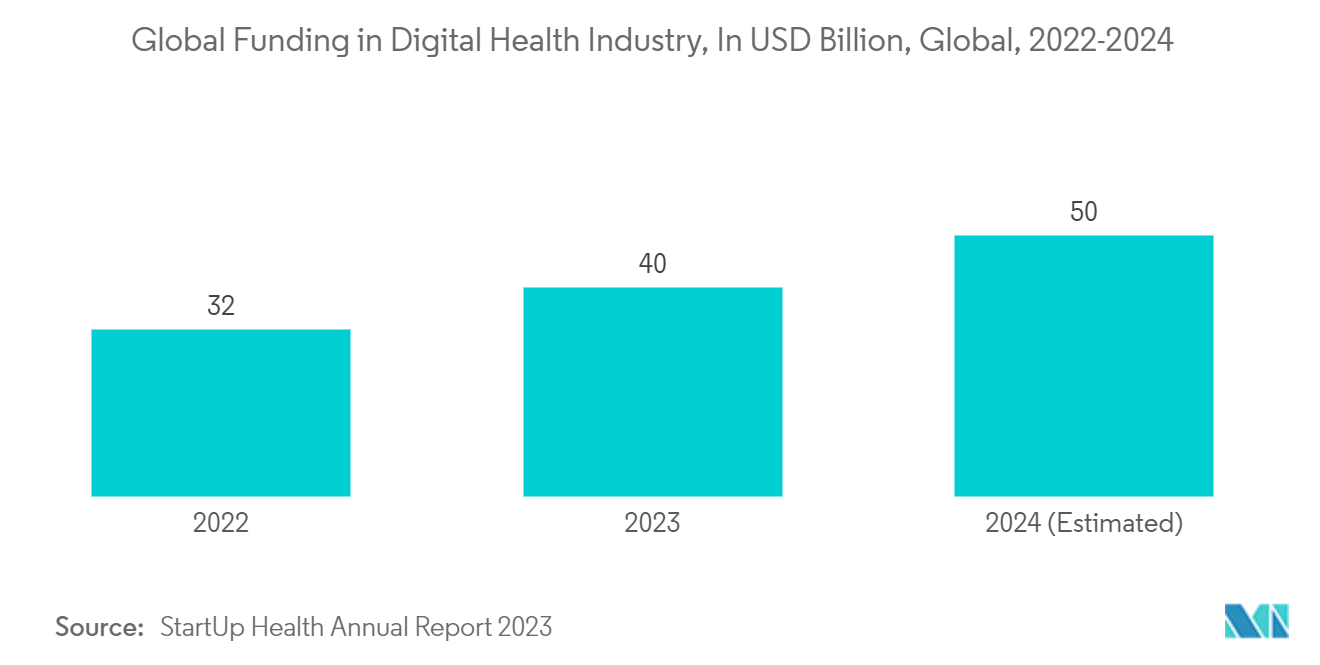
North America is Expected to Hold a Significant Share in the Market Studied
North America is expected to hold a significant share in the market studied over the forecast period owing to factors such as the increasing adoption of digital health and rising advancements in wireless medical technologies.
According to the Canadian Digital Health Survey of April 2024, around 83% of the studied population was interested in sending prescriptions directly to the pharmacy through the patient portal, and around 59% of the population was interested in teleconsultation. Hence, the rising interest in digital-enabled health services is expected to increase the adoption of wireless medical technologies to share important medical data.
In June 2022, GE Healthcare launched Portrait Mobile, a wireless patient monitoring system that continuously monitors a patient's stay. The wireless patient monitoring system helps clinicians detect patient deterioration. Portrait Mobile includes patient-worn wireless sensors that communicate with a mobile monitor. Similarly, in January 2022, North Carolina-headquartered Novant Health, a three-state integrated network of physician clinics, outpatient centers, and hospitals, reported the deployment of Extreme Networks' enterprise-grade Wi-Fi 6E solution. The Extreme AP4000 access point (AP) investment will enable the hospital to provide high-speed Wi-Fi throughout its facilities and allow dedicated, secure connectivity for mission-critical healthcare apps and medical devices.
Thus, the increasing adoption of digital health and the rising advancement in wireless medical technologies in North America are expected to drive the growth of the market over the forecast period.
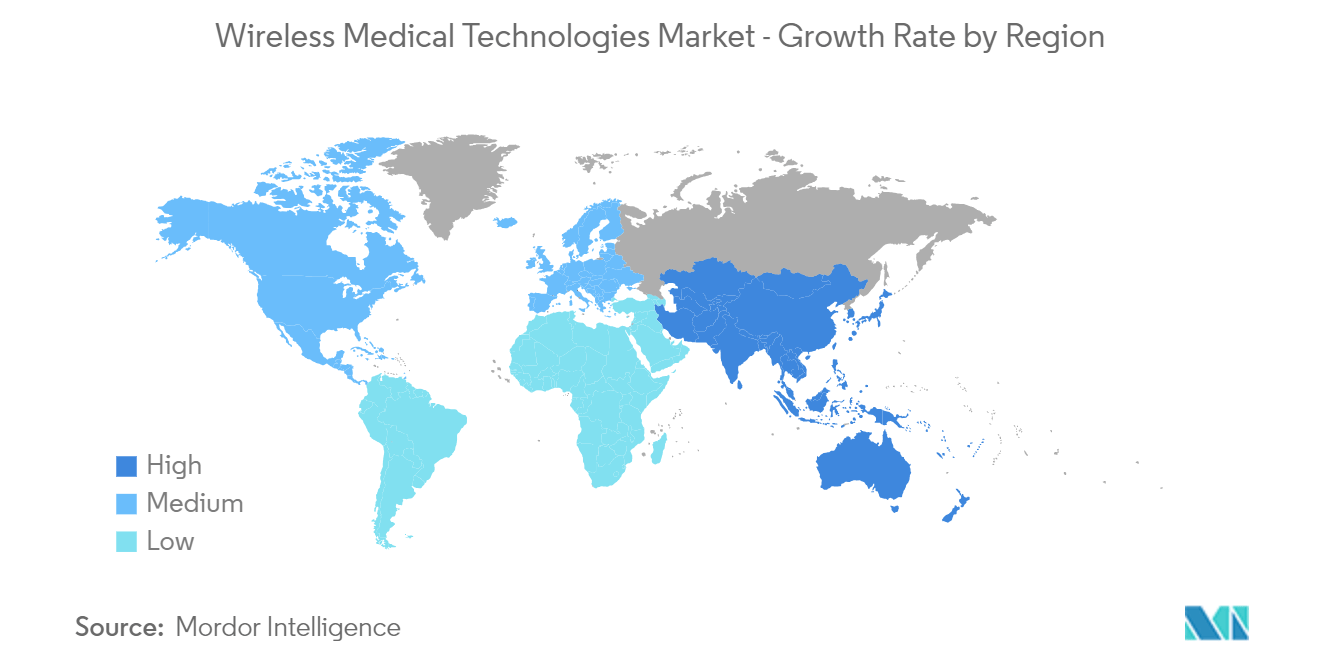
Wireless Medical Technologies Industry Overview
The wireless medical technologies market is competitive in nature, with several companies operating in the business. With the increasing adoption of healthcare technology across the world, companies are focusing more on new product launches with advanced technologies. Some of the key companies in the market include Koninklijke Philips NV, GE Healthcare, McKesson Corporation, Cisco Systems, and Medtronic PLC.
Wireless Medical Technologies Market Leaders
-
Koninklijke Philips N.V.
-
Cisco Systems
-
GE Healthcare
-
Medtronic Plc
-
McKesson Corporation
*Disclaimer: Major Players sorted in no particular order
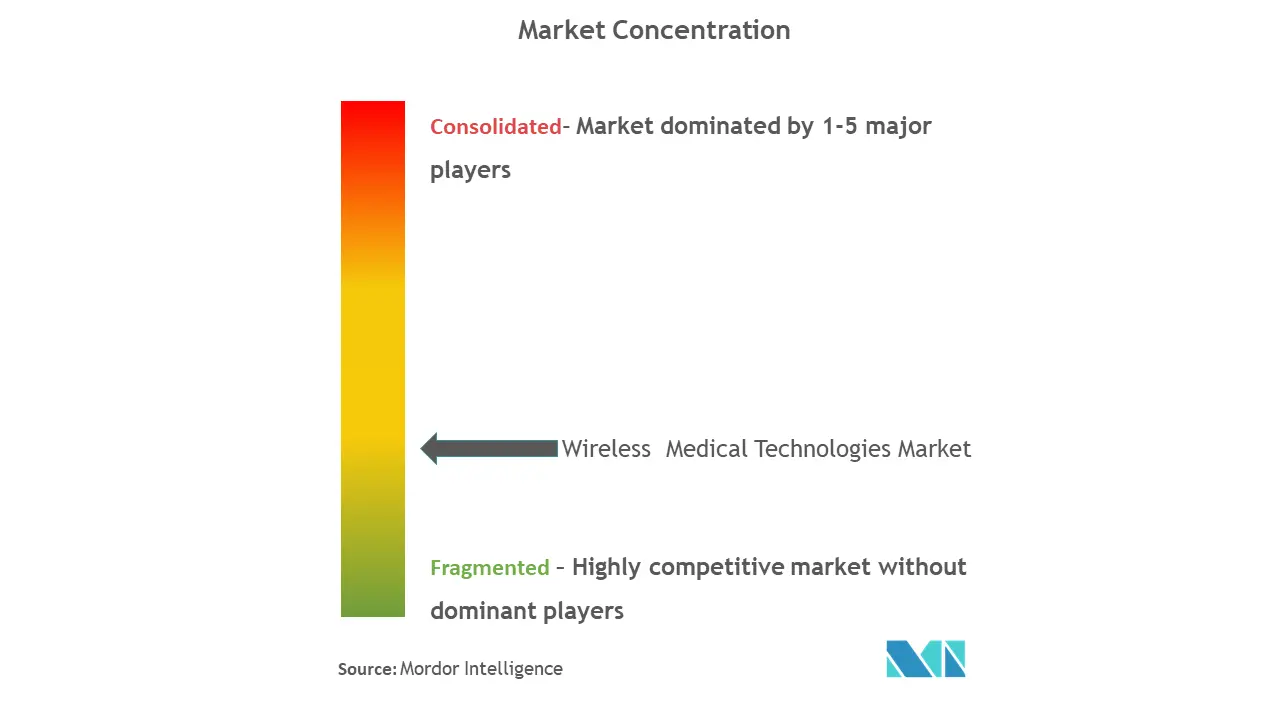
Wireless Medical Technologies Market News
- February 2024: KORE and Medical Guardian collaborated on the launch of a medical alert device utilizing eSIM technology. This technology is designed to overcome cell signal challenges and address healthcare access disparities by enabling electronic switching of service carriers for optimal 24/7 connectivity.
- March 2023: Cherish and AT&T launched Cherish Serenity, an in-home sensing device to help monitor the health of aging adults. Serenity uses patented radar technology that allows it to monitor people across multiple rooms in a home without additional equipment.
Wireless Medical Technologies Market Report - Table of Contents
1. INTRODUCTION
1.1 Study Assumptions and Market Definition
1.2 Scope of the Study
2. RESEARCH METHODOLOGY
3. EXECUTIVE SUMMARY
4. MARKET DYNAMICS
4.1 Market Overview
4.2 Market Drivers
4.2.1 Increasing Demand for Digitalization of Healthcare
4.2.2 Rising Technological Advancements in Wireless Medical Technologies.
4.3 Market Restraints
4.3.1 Cyber Security and Privacy Issues
4.4 Porter's Five Forces Analysis
4.4.1 Threat of New Entrants
4.4.2 Bargaining Power of Buyers/Consumers
4.4.3 Bargaining Power of Suppliers
4.4.4 Threat of Substitute Products
4.4.5 Intensity of Competitive Rivalry
5. MARKET SEGMENTATION (Market Size by Value – USD)
5.1 By Technology
5.1.1 Wireless Wide Area Network (WWAN)
5.1.2 Wireless Personal Area Network (WPAN)
5.1.3 Worldwide Interoperability for Microwave Access (WiMAX)
5.1.4 Wireless Body Area Networks (WBANs)
5.2 By Application
5.2.1 Patient-specific
5.2.2 Provider-specific
5.3 By Component Type
5.3.1 Software
5.3.2 Hardware
5.3.3 Services
5.4 By End-user
5.4.1 Provider
5.4.2 Payers
5.4.3 Patients
5.5 Geography
5.5.1 North America
5.5.1.1 United States
5.5.1.2 Canada
5.5.1.3 Mexico
5.5.2 Europe
5.5.2.1 Germany
5.5.2.2 United Kingdom
5.5.2.3 France
5.5.2.4 Italy
5.5.2.5 Spain
5.5.2.6 Rest of Europe
5.5.3 Asia-Pacific
5.5.3.1 China
5.5.3.2 Japan
5.5.3.3 India
5.5.3.4 Australia
5.5.3.5 South Korea
5.5.3.6 Rest of Asia-Pacific
5.5.4 Middle East and Africa
5.5.4.1 GCC
5.5.4.2 South Africa
5.5.4.3 Rest of Middle East and Africa
5.5.5 South America
5.5.5.1 Brazil
5.5.5.2 Argentina
5.5.5.3 Rest of South America
6. COMPETITIVE LANDSCAPE
6.1 Company Profiles
6.1.1 Koninklijke Philips N.V
6.1.2 McKesson Corporation
6.1.3 GE Healthcare
6.1.4 Cisco Systems
6.1.5 Medtronic Plc
6.1.6 Oracle
6.1.7 Samsung Electronics Co. Ltd (Samsung Healthcare)
6.1.8 Mesimo
6.1.9 Fitbit
6.1.10 Omron Healthcare
- *List Not Exhaustive
7. MARKET OPPORTUNITIES AND FUTURE TRENDS
Wireless Medical Technologies Industry Segmentation
Wireless medical technologies integrated into traditional medicine, such as diagnosis, monitoring, and treatment of illness, can help individuals improve their personal health and well-being.
The wireless medical technology market is segmented by technology, application, component type, end user, and geography. By technology, the market is segmented into wireless wide area network (WWAN), wireless personal area network (WPAN), worldwide interoperability for microwave access (WiMAX), and wireless body area network (WBAN). By application, the market is segmented into patient-specific and provider-specific. By component, the market is segmented into software, hardware, and services. By end user, the market is segmented into providers, payers, and patients. By geography, the market is segmented into Geography (North America, Europe, Asia-Pacific, Middle East and Africa, and South America). The report offers market size and forecast in terms of value (USD) for the above segments.
| By Technology | |
| Wireless Wide Area Network (WWAN) | |
| Wireless Personal Area Network (WPAN) | |
| Worldwide Interoperability for Microwave Access (WiMAX) | |
| Wireless Body Area Networks (WBANs) |
| By Application | |
| Patient-specific | |
| Provider-specific |
| By Component Type | |
| Software | |
| Hardware | |
| Services |
| By End-user | |
| Provider | |
| Payers | |
| Patients |
| Geography | ||||||||
| ||||||||
| ||||||||
| ||||||||
| ||||||||
|
Wireless Medical Technologies Market Research FAQs
How big is the Wireless Medical Technologies Market?
The Wireless Medical Technologies Market size is expected to reach USD 51.20 billion in 2025 and grow at a CAGR of 11.42% to reach USD 87.92 billion by 2030.
What is the current Wireless Medical Technologies Market size?
In 2025, the Wireless Medical Technologies Market size is expected to reach USD 51.20 billion.
Who are the key players in Wireless Medical Technologies Market?
Koninklijke Philips N.V., Cisco Systems, GE Healthcare, Medtronic Plc and McKesson Corporation are the major companies operating in the Wireless Medical Technologies Market.
Which is the fastest growing region in Wireless Medical Technologies Market?
Asia-Pacific is estimated to grow at the highest CAGR over the forecast period (2025-2030).
Which region has the biggest share in Wireless Medical Technologies Market?
In 2025, the North America accounts for the largest market share in Wireless Medical Technologies Market.
What years does this Wireless Medical Technologies Market cover, and what was the market size in 2024?
In 2024, the Wireless Medical Technologies Market size was estimated at USD 45.35 billion. The report covers the Wireless Medical Technologies Market historical market size for years: 2019, 2020, 2021, 2022, 2023 and 2024. The report also forecasts the Wireless Medical Technologies Market size for years: 2025, 2026, 2027, 2028, 2029 and 2030.
Wireless Medical Technologies Industry Report
Statistics for the 2025 Wireless Medical Technologies market share, size and revenue growth rate, created by Mordor Intelligence™ Industry Reports. Wireless Medical Technologies analysis includes a market forecast outlook for 2025 to 2030 and historical overview. Get a sample of this industry analysis as a free report PDF download.



